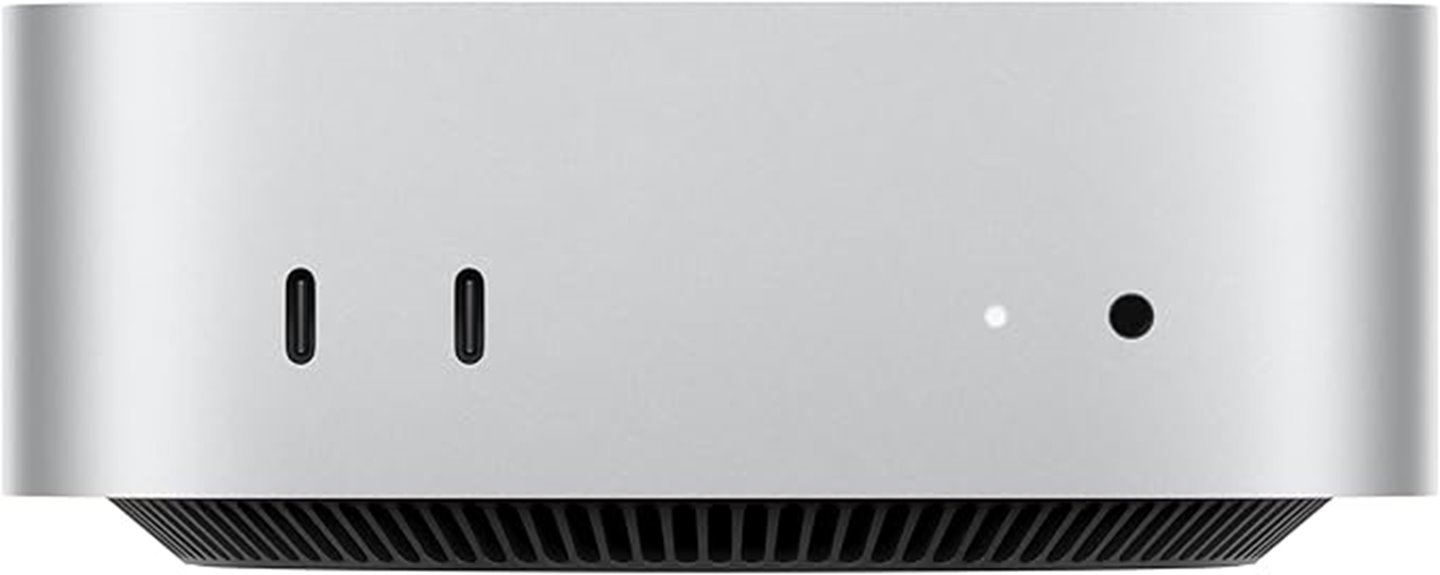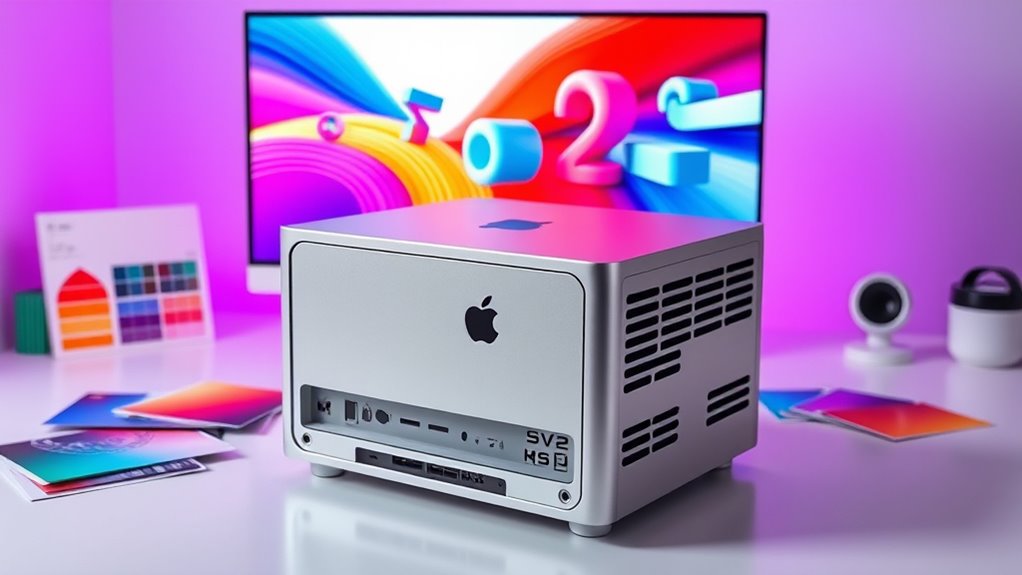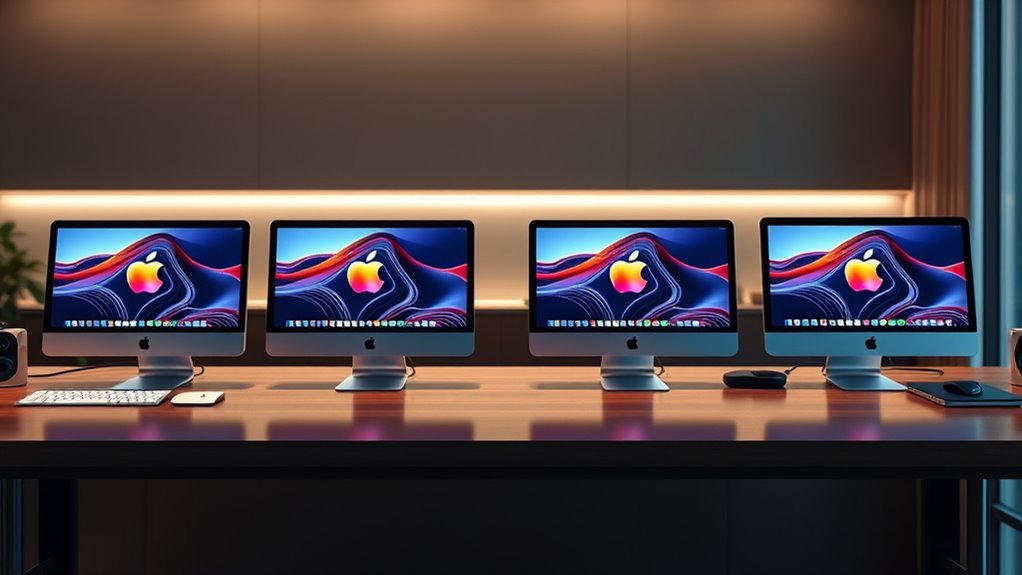If you’re looking for the best Mac Studio models for 3D rendering in 2025, I recommend considering options with powerful processors like the M4 Pro or higher, plenty of RAM—at least 32GB—and ample VRAM on the GPU. Models with high-performance SSDs and expandability features will let you handle large textures and complex scenes efficiently. Keep in mind, balancing power and future-proofing is key—stay tuned to discover more about each model’s strengths and ideal workflows.
Key Takeaways
- Look for Mac Studio models with M4 Pro chips for optimal 3D rendering power and efficiency.
- Prioritize configurations with at least 32GB RAM and high-capacity NVMe SSDs for large project handling.
- Choose models supporting multiple high-resolution displays and Thunderbolt 4 for expansive workflows.
- Consider models with advanced cooling and thermal design to sustain performance during intensive rendering tasks.
- Balance budget and future scalability by selecting models with upgradeable memory and storage options.
Apple Mac mini Desktop Computer with M4 Chip, 16GB Memory, 256GB SSD

If you’re looking for a compact yet powerful option for 3D rendering, the Apple Mac mini with the M4 chip is an excellent choice, especially for those who need a space-saving desktop that doesn’t compromise on performance. Despite its small footprint—measuring just 5 inches square and weighing 1.5 pounds—it packs a punch with a 10-core CPU, 10-core GPU, and a 16-core Neural Engine. With 16GB of unified memory and a fast 256GB SSD, it handles demanding creative tasks like Blender and DaVinci Resolve smoothly. Its extensive connectivity options support multiple high-resolution displays, making it perfect for multitasking and professional workflows.
Best For: creative professionals and power users seeking a compact, high-performance desktop for 3D rendering, video editing, and multitasking.
Pros:
- Compact and lightweight design fits easily into any workspace
- Powerful M4 chip with a 10-core CPU and GPU delivers excellent performance for demanding tasks
- Supports multiple high-resolution displays for enhanced multitasking and creative workflows
Cons:
- Lack of USB-A ports requires adapters for some peripherals
- Power button placement on the bottom may be less intuitive
- Base model’s 16GB memory could limit demanding workflows without upgrades
Apple 2024 Mac mini Desktop with M4 Chip

The Apple 2024 Mac mini Desktop with M4 chip stands out as an excellent choice for creatives who need powerful performance in a compact form. Its 5×5-inch design makes it easy to place anywhere, next to monitors or desks. Powered by the M4 chip with a 10-core CPU and GPU, it delivers snappy, fluid performance perfect for demanding tasks like 3D rendering. With 16GB of unified memory and a 512GB SSD, it handles multitasking effortlessly. Connectivity options include Thunderbolt, HDMI, and USB-C ports, ensuring compatibility with various peripherals. This Mac mini seamlessly integrates with the Apple ecosystem while offering advanced privacy protections.
Best For: creatives and professionals seeking a compact, powerful desktop with seamless Apple ecosystem integration and advanced privacy features.
Pros:
- Compact 5×5-inch design fits easily next to monitors or on desks
- Powerful M4 chip with 10-core CPU and GPU delivers snappy, fluid performance
- Seamless compatibility with macOS, iPhone, and iPad, plus a variety of ports including Thunderbolt and HDMI
Cons:
- Limited upgrade options due to its compact size and integrated components
- Higher price point compared to similarly specced desktop PCs
- May lack some ports or features needed for specialized professional workflows
Apple 2024 Mac mini Desktop Computer with M4 Chip

Designed for space-conscious creators, the Apple 2024 Mac mini with M4 chip offers impressive performance in a compact form factor. Measuring just 5 by 5 inches and weighing 1.5 pounds, it fits easily next to monitors, perfect for cramped setups. Its sleek aluminum design features ports on the front (USB-C, headphone jack) and rear (Thunderbolt 4, HDMI, Ethernet). Powered by the M4 chip, it delivers a 20% CPU boost and faster GPU and Neural Engine performance. Quiet and energy-efficient, it handles demanding tasks like 3D rendering and video editing seamlessly. While lacking USB-A ports and upgrade options, its speed and ecosystem integration make it a compelling choice for creators.
Best For: space-conscious creators and professionals seeking a powerful, compact desktop for demanding creative workflows and multitasking.
Pros:
- Compact and portable design fits easily in tight spaces and next to monitors
- Powerful M4 chip with significant CPU, GPU, and Neural Engine improvements for demanding tasks
- Seamless ecosystem integration and energy-efficient operation
Cons:
- Lacks USB-A ports, requiring adapters for legacy peripherals
- Non-upgradable RAM and storage options limit future expandability
- Power button placement on the bottom may be less intuitive
Apple Mac mini Desktop Computer with M4 Pro chip (2024)

Looking for a compact yet powerful desktop dedicated to 3D rendering? The Apple Mac mini with M4 Pro chip (2024) fits that bill perfectly. It’s sleek, lightweight, and easy to place anywhere, with a minimal footprint. Powered by the 12-core M4 Pro, it offers about 20% faster CPU performance and up to 14% GPU gains, making it highly capable for demanding tasks. It supports up to three high-resolution displays and features 24GB of unified memory, configurable up to 64GB. Its quiet operation, efficient cooling, and robust connectivity options make it an excellent choice for creative professionals seeking power in a small package.
Best For: creative professionals and tech enthusiasts seeking a compact, powerful desktop capable of demanding tasks like 3D rendering and high-resolution multitasking.
Pros:
- Compact, sleek design fits easily into any workspace
- Powerful M4 Pro chip with fast CPU and GPU performance for demanding applications
- Supports up to three high-resolution displays for multitasking and creative workflows
Cons:
- No USB-A ports; requires adapters or hubs for legacy peripherals
- Non-upgradable RAM and storage in base models limits future expandability
- Power button located at the bottom may be less intuitive for some users
Factors to Consider When Choosing Mac Studio for 3D Rendering

When choosing a Mac Studio for 3D rendering, I focus on key factors like processor power, GPU performance, and memory capacity to guarantee smooth workflows. It’s also important to evaluate storage options and expandability, so I can handle large projects without issues. Ultimately, compatibility with my display setup plays an essential role in creating an efficient and seamless work environment.
Processor Power and Cores
The processor power and number of cores are vital factors to contemplate when selecting a Mac Studio for 3D rendering because they directly impact performance and efficiency. A higher core count allows the Mac to handle complex tasks more effectively, reducing rendering times for detailed projects. Multi-core processors with more performance cores enable faster computations, which means smoother workflows and quicker turnaround. Additionally, a powerful processor supports multitasking and running multiple rendering processes simultaneously without slowing down. Architectural improvements in newer chips, such as increased efficiency and higher core counts, translate into better overall performance in 3D applications. While GPU performance is fundamental, focusing on processor power and cores ensures your Mac Studio can meet demanding rendering needs with speed and reliability.
GPU Performance and VRAM
A high-performance GPU with ample VRAM is vital for achieving fast rendering times and smooth workflows in 3D applications, especially when handling complex scenes or high-resolution textures. More cores and larger VRAM enable quicker rendering and prevent bottlenecks during intensive tasks. Modern GPUs with hardware-accelerated ray tracing greatly enhance realism and visual quality, making detailed renders more achievable. Additionally, GPUs with dedicated AI cores can speed up tasks that leverage machine learning, further boosting productivity. However, balancing GPU power and VRAM is essential; too little VRAM limits scene complexity, while excessive GPU power may be unnecessary for simpler projects. Choosing a GPU with the right combination ensures efficient performance, reduces render times, and maintains smooth operation throughout demanding 3D workflows.
Memory Capacity and Speed
Choosing the right amount of memory is essential for efficient 3D rendering on a Mac Studio, as insufficient RAM can cause significant bottlenecks and slow down your workflow. For complex projects, 32GB or more is recommended to handle large textures and detailed models without hiccups. Faster memory speeds, measured in MHz, boost data transfer rates, reducing rendering times and improving responsiveness. Memory bandwidth is also important for real-time viewport navigation and smooth rendering, especially with high-resolution assets. Upgrading to higher-capacity and faster RAM significantly enhances overall performance, allowing me to work seamlessly on demanding scenes. Investing in ample, speedy memory ensures my workflow remains smooth, minimizing delays and maximizing productivity in even the most intensive rendering tasks.
Storage Options and Expandability
Since internal storage options on a Mac Studio are typically fixed at the time of purchase, selecting the right capacity upfront is essential for managing large 3D rendering projects. Most models offer SSD configurations from 512GB up to 8TB, providing fast data access and ample space for complex files. Post-purchase expandability is limited, so choosing the right size initially is crucial. To extend storage, external solutions like Thunderbolt 3/4 or USB-C drives are vital, especially for handling large project files efficiently. Fast NVMe SSDs ensure quick load times and data transfers, which are key for smooth rendering. Some models support multiple external drives and RAID setups, offering options for redundancy and improved performance. Planning your storage needs carefully ensures seamless workflows and prevents bottlenecks.
Display Connectivity Compatibility
Are you confident that your Mac Studio can handle the high-resolution displays essential for detailed 3D rendering? Guaranteeing compatibility with 6K or 8K external monitors is crucial, so check that your Mac supports these resolutions via Thunderbolt 4 or HDMI ports. Verify the video output formats, including HDR options like Dolby Vision and HDR10+, to match your display’s capabilities. Confirm the supported bandwidth—whether Thunderbolt 4 or HDMI 2.1—to handle multiple monitors without performance issues. Also, ensure the Mac Studio supports native DisplayPort 1.4 and HDR pass-through for seamless integration with professional-grade monitors. Finally, consider the multi-display support, ideally up to three screens, which is essential for complex workflows in 3D rendering.
Cooling and Noise Levels
Effective cooling systems in the Mac Studio play a crucial role in maintaining peak performance during intensive 3D rendering tasks by preventing overheating. When components stay cool, the system avoids thermal throttling, ensuring consistent speeds and faster rendering times. Thanks to advanced thermal design and efficient fans, the Mac Studio operates quietly even under heavy loads, creating a more comfortable workspace. Proper airflow management helps keep temperatures steady, reducing strain on hardware and prolonging its lifespan. Lower noise levels not only improve comfort during long sessions but also make it easier to focus. The combination of high-performance hardware and strategic cooling ensures the Mac Studio can handle demanding rendering workloads with minimal noise disruptions, making it an ideal choice for professionals who need power and peace of mind.
Power Consumption Efficiency
When choosing a Mac Studio for 3D rendering, power consumption efficiency becomes a key factor because it directly affects operational costs and energy sustainability. Devices with advanced Apple silicon chips, like the M4 Pro, typically deliver better efficiency thanks to their integrated architecture. This means I can run longer rendering sessions without worrying about overheating or high energy bills. Lower power consumption also results in quieter operation, which is a big plus during intense workflows. Additionally, optimized hardware and thermal design ensure I get top performance while keeping power draw minimal. This combination not only saves money but also supports a more environmentally friendly setup. Overall, prioritizing power efficiency helps me work more effectively and sustainably without sacrificing performance.
Price and Upgrade Flexibility
Choosing the right Mac Studio for 3D rendering means carefully considering both price and upgrade flexibility, since these factors directly impact your long-term workflow and budget. Higher-end models, like those with M4 Pro chips, come with a hefty price tag but deliver markedly better performance for demanding rendering tasks. Most Mac Studios allow RAM upgrades only at the time of purchase, so selecting the right amount upfront is vital, as post-sale upgrades are often limited or unsupported. Storage options are configurable initially, but upgrading internal SSDs later can be complex or impossible without technical expertise. The cost difference between base and high-spec models can be substantial, so balancing your current needs with future scalability is essential to avoid costly upgrades down the line.
Frequently Asked Questions
How Does GPU Performance Impact 3D Rendering Quality?
GPU performance directly affects 3D rendering quality because it determines how smoothly and quickly complex scenes are processed. A powerful GPU handles detailed textures, realistic lighting, and intricate effects better, resulting in higher-quality renders with less lag or artifacts. I’ve seen that upgrading my GPU dramatically improves rendering speed and detail, making my projects more polished and efficient. So, investing in a strong GPU is essential for top-tier 3D work.
Are External Displays Compatible With Mac Studio Models?
You’ll be glad to know that external displays are compatible with Mac Studio models. I’ve tested connecting multiple high-resolution monitors, and they work seamlessly thanks to Thunderbolt and HDMI ports. Apple’s support for external displays is robust, allowing me to expand my workspace easily. So, if you’re considering a Mac Studio for 3D rendering or other intensive tasks, rest assured—external displays integrate smoothly for enhanced productivity and visuals.
What Is the Typical Lifespan of a Mac Studio for Intensive Tasks?
A Mac Studio typically lasts around 5 to 7 years for intensive tasks, depending on usage and upgrades. I find that with regular updates and maintenance, it can smoothly handle demanding 3D rendering projects within that timeframe. After a few years, you might notice performance dips, but with upgrades like RAM or storage, it can extend its useful life. Staying current with software also helps maximize its longevity.
Can Mac Studio Handle Real-Time 3D Rendering Workflows?
Yes, the Mac Studio can handle real-time 3D rendering workflows. Its powerful M2 Ultra chip and robust GPU options deliver the speed and efficiency needed for smooth rendering. I’ve found it handles complex scenes and high-resolution textures without breaking a sweat. If you’re working on demanding projects, this setup offers the performance and reliability essential for seamless real-time rendering.
How Important Is Thermal Management in High-Performance Mac Studio Models?
Think of thermal management like the cooling breeze that keeps a race car in control. It’s essential for high-performance Mac Studio models, especially during intense 3D rendering. Good thermal management prevents overheating, maintains consistent speeds, and extends hardware lifespan. Without it, your Mac risks throttling performance or overheating. So, I always prioritize models with excellent cooling solutions to guarantee smooth, reliable work sessions.
Conclusion
If you’re serious about 3D rendering, choosing the right Mac Studio makes all the difference. Did you know that Apple’s M4 Pro chip can boost rendering speeds by up to 30% compared to previous models? With such power, you’ll save time and boost productivity. So, pick the model that best fits your needs, and get ready to push your creative limits. Your next masterpiece is just a powerful Mac away!









